The old sea locks of IJmuiden allow seagoing vessels to travel as far as Amsterdam. Yet the largest of the new generation of ships are unable to pass through. With the help of KfW IPEX-Bank, a gigantic new lock for ocean giants was built and ceremoniously opened by Dutch King Willem on 26 January 2022.
The traffic controller guides the "Gracious Ace" carefully through the sea lock. Centimetre by centimetre, the 199-metre-long and 32-metre-wide car carrier edges across the panorama of the city of IJmuiden. The sight of huge sidewalls passing by their office windows has become commonplace for the men and women in the portacabins of the OpenIJ consortium, which are located close to the sea lock. They are currently working on a project that in the year 2022 will allow ships twice the size of the "Gracious Ace" to easily access the port of Amsterdam.
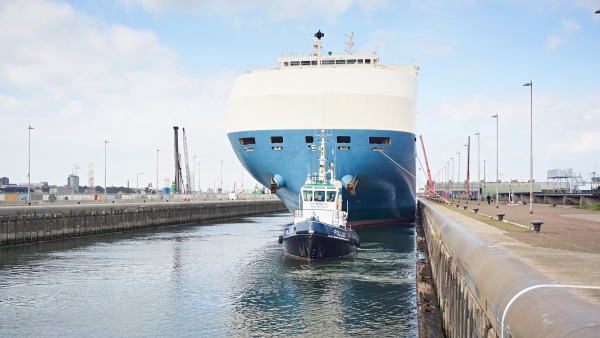
At the limit
Car carriers such as the 32-metre-wide "Gracious Ace" can still navigate the old Noordersluis.
IJmuiden is located at the mouth of the 27-kilometre-long North Sea Channel that links Amsterdam with the sea. There the Dutch Government is building the world's largest sea lock: 500 metres long, 70 metres wide and 18 metres deep.
It will be 100 metres longer, 20 metres wider and three meters deeper than the Northern Lock (Noordersluis) into which the Pollux tug is currently manoeuvring the car carrier. This sea lock already made the headlines in the year of its completion in 1929, as the "world's largest sea lock". "The sea lock must always be navigable, even at low tide", explained Jaap Blokland, project director Engineering Procurement and Construction (EPC) at OpenIJ: it is one of the requirements for the new construction. "The old sea lock is too narrow for large cruise liners", added Carlo Kuiper, project director of the project company at OpenIJ. Some vessels therefore opt for Rotterdam instead.
However, passengers are a desirable clientele, generating revenue in shops and restaurants. With 95 million tonnes of cargo handled in 2015, Amsterdam is ranked fourth of Europe's largest ports, behind Rotterdam, Antwerp and Hamburg. Solid bulk cargo, such as agricultural products, fertiliser or fossil fuels, is mainly unloaded on Amsterdam's quays. Amsterdam is also the world's largest petrol port. And that is not all: 182 ocean-going cruise liners anchored in the Netherlands' largest city last year.
All shipping traffic between the port and the North Sea has to pass through the IJmuiden bottleneck. This means having to navigate four different sea locks in total. They are located adjacent to each other on islands and with these form a barrier in the mouth of the channel, which at the same time constitutes part of the Dutch coastal protection against flooding from the North Sea. The islands are the remains of the dunes that were removed when the channel was constructed 140 years ago. The settlement of channel diggers evolved to become the city of IJmuiden with 30,000 inhabitants.
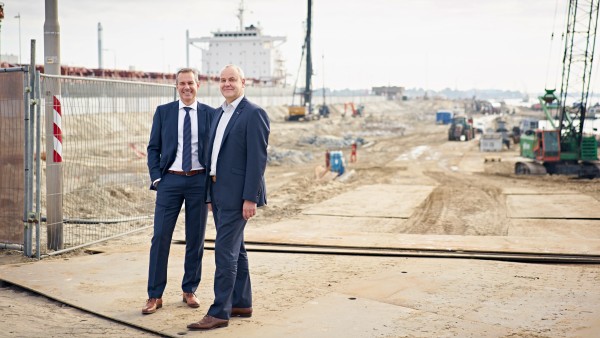
Speed is ensured
Carlo Kuiper (left) and Jaap Blokland are coordinating the sea lock construction.
The water surrounding the construction site is buzzing with activity. Ships deliver wheel loaders and excavators. Floating cranes are anchored where the underwater base for the first lock gate will be positioned. The daily schedules have to be approved by the Port of Amsterdam; after all, traffic on the channel has to flow without interruption. According to Jaap Blokland, one of the main challenges the project faces is the "tight schedule". The contract was awarded in September 2015 to OpenIJ, a joint venture between the Dutch construction groups Royal BAM and Volker Wessels, together with financial investors.
Preparatory work started a few months later. This involved clearing underground bunkers and looking for duds from the Second World War, among other things. The new sea lock should be in continuous operation no later than in January 2022, although the first ships will have already tested it before then. The extremely tight construction site adds further complication. The four existing locks will continue operating non-stop. The construction site is located in the midst of all this activity, as the new lock is positioned between the Northern and Middle Lock.
The new lock not only differs from the Noordersluis in terms of size; it will have a wider range of uses, too. Given that it is substantially deeper, it can be operated regardless of the tides. Captains of ocean-going giants previously had to sometimes wait for high tide or transship part of the cargo in IJmuiden to smaller vessels.
The lock walls will soar five metres above the current water level, thus providing defence against rising sea levels brought about by climate change while also strengthening the country's flood control. The enormous trough will be cast from 290,000 cubic metres of cement – three times as much as, for example, the new European Central Bank building in Frankfurt.
Read more below the infographic.
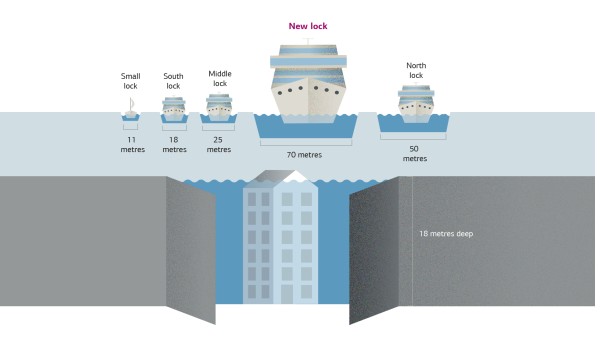
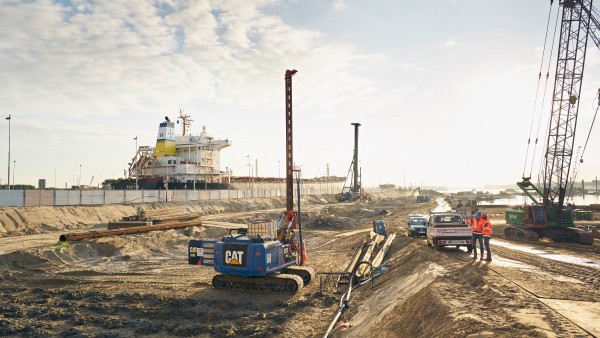
The Challenge
The new sea lock will be contructed between two existing locks in the channel leading to the North Sea.
The contracting authority of the EUR 500-million-project is Rijkswaterstaat, the executive agency of the Dutch Ministry of Infrastructure and the Environment. Some of the funds for the massive new construction undertaking come from Germany. In addition to private banks and the European Investment Bank, KfW IPEX-Bank is participating in the project funding. "Expanding European infrastructure is part of our mandate" is how Christian Bevc, Global Head of Transport and Social Infrastructure, KfW IPEX-Bank, explains the commitment of the international specialist financier.
The IJmuiden sea lock is one of the so-called Trans-European Networks that are partly financed by the EU’s TEN-T programme. The new Kieldrechtlock in the port of Antwerp, which was opened in summer 2016 and is only marginally smaller than the new construction in IJmuiden, is also part of the same network. A significant share of German exports and imports are processed via the seaports in the Netherlands and in Belgium. Christian Bevc also stressed that the IJmuiden project is a public-private partnership (PPP). PPPs can generate efficiency gains as a "procurement alternative to the public sector and possibly speed up the completion of a project."
OpenIJ is particularly proud of the design of the lock gates. Project director Kuiper explained that the outer gates of sea locks are usually higher than the inner gates. Here, however, the "fundamental design decision" was to build both gates the same height. This means that only one replacement gate is needed instead of two, reducing the cost. Additionally, because the water flows in and out through 16 openings in the gate, each measuring nine square metres, this also saves on the channels outside the lock chamber, through which the lock chamber is usually filled and emptied. A single lock gate is 77 metres wide, 25 metres high and eleven metres thick. Each of these massive steel structures weighs 2,400 tonnes and is welded together in South Korea under constant surveillance by OpenIJ experts on site. The gates are expected to arrive in IJmuiden by ship in early 2018.
Hydraulic engineering projects are long-term. The old Noordersluis, which was inaugurated by the Dutch Queen Wilhelmina in 1930, is expected to be out of order when the new sea lock is in operation. How many years will its successor last? "100 years as well" project director Jaap Blokland estimates. "At least".
Published on KfW Stories:on 17 February 2017, updated on 26 January 2022.
The described project contributes to the following United Nationsʼ Sustainable Development Goals
Goal 9: Build resilient infrastructure, promote sustainable industrialization and foster innovation
Non-existent or dilapidated infrastructure hinders economic efficiency and thus engenders poverty. When building infrastructure, the focus should be on sustainability, for example, by promoting environmentally-friendly means of transport. Factories and industrial facilities should also ensure that production is in line with ecological aspects to avoid unnecessary environmental pollution.

All United Nations member states adopted the 2030 Agenda in 2015. At its heart is a list of 17 goals for sustainable development, known as the Sustainable Development Goals (SDGs). Our world should become a place where people are able to live in peace with each other in ways that are ecologically compatible, socially just, and economically effective.

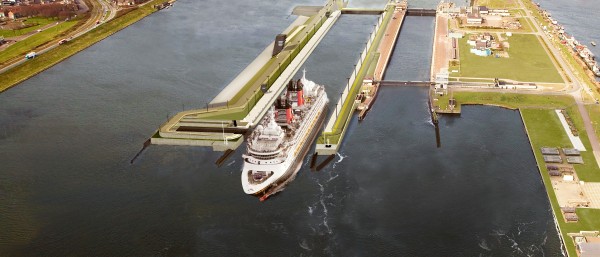
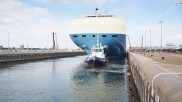
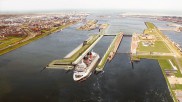
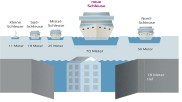
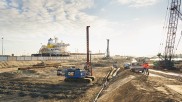
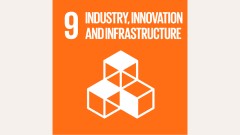

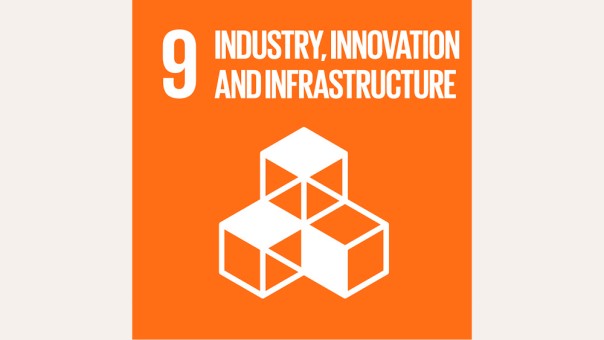

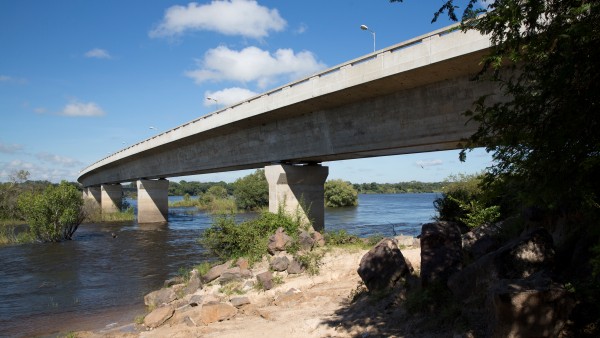
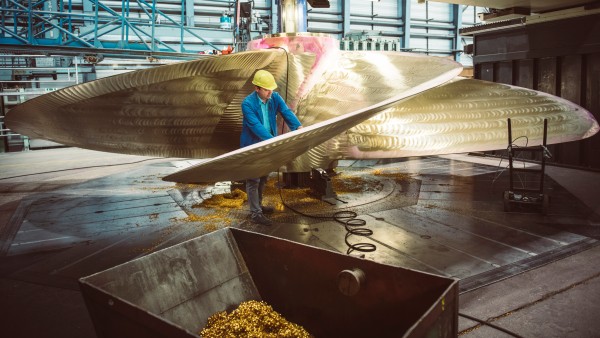
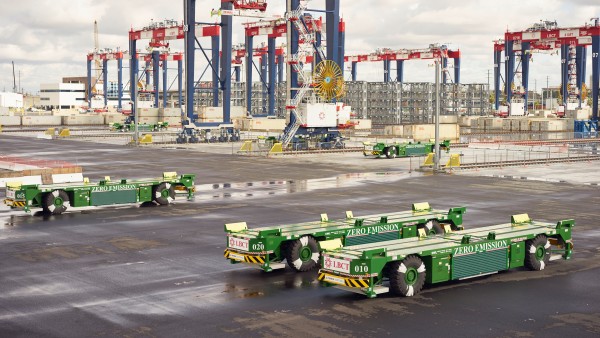
Data protection principles
If you click on one of the following icons, your data will be sent to the corresponding social network.
Privacy information